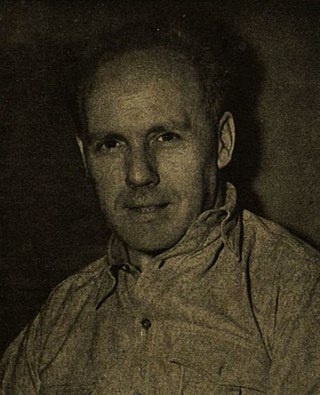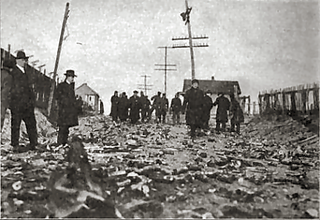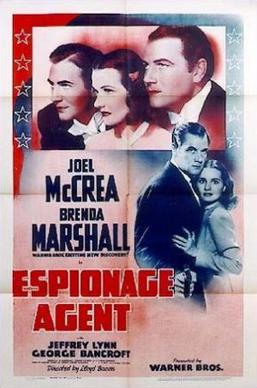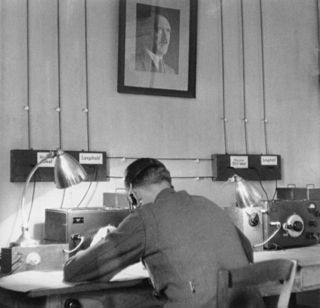Related Research Articles

Sabotage is a deliberate action aimed at weakening a polity, government, effort, or organization through subversion, obstruction, demoralization, destabilization, division, disruption, or destruction. One who engages in sabotage is a saboteur. Saboteurs typically try to conceal their identities because of the consequences of their actions and to avoid invoking legal and organizational requirements for addressing sabotage.

The Danish resistance movements were an underground insurgency to resist the German occupation of Denmark during World War II. Due to the initially lenient arrangements, in which the Nazi occupation authority allowed the democratic government to stay in power, the resistance movement was slower to develop effective tactics on a wide scale than in some other countries.

The Black Tom explosion was an act of sabotage by agents of the German Empire, to destroy U.S.-made munitions that were to be supplied to the Allies in World War I. The explosions occurred on July 30, 1916, in New York Harbor, killing at least 7 people and wounding hundreds more. It also caused damage of military goods worth some $20,000,000. This incident, which happened prior to U.S. entry into World War I, also damaged the Statue of Liberty. It was one of the largest artificial non-nuclear explosions in history.

Kedyw (Polish pronunciation:[ˈkɛdɨf], partial acronym of Kierownictwo Dywersji was a Polish World War II Home Army unit that conducted active and passive sabotage, propaganda and armed operations against Nazi German forces and collaborators.

Seán Russell was an Irish republican who participated in the Easter Rising of 1916, held senior positions in the Irish Republican Army during the Irish War of Independence and Irish Civil War, and was Chief of Staff of the IRA from c. 1938 to April 1939 upon the onset of World War II. It was under Russell's leadership that the IRA began the Sabotage Campaign, in which the group began bombing civil, economic and military infrastructure in the United Kingdom, primarily England, between 1939 and 1940. In the same period, Russell actively collaborated with Nazi Germany; in early 1940 he travelled to Germany, where he personally met with German foreign minister Joachim von Ribbentrop and spent three months training in the use of explosives. In August 1940 Russell was to return to Ireland as part of a joint IRA/German plan entitled Operation Dove, however, Russell died aboard a Kriegsmarine U-boat transporting him home following a sudden stomach illness and he was subsequently buried at sea.
The S-Plan or Sabotage Campaign or England Campaign was a campaign of bombing and sabotage against the civil, economic and military infrastructure of the United Kingdom from 1939 to 1940, conducted by members of the Irish Republican Army (IRA). It was conceived by Seamus O'Donovan in 1938 at the request of then IRA Chief of Staff Seán Russell. Russell and Joseph McGarrity are thought to have formulated the strategy in 1936. During the campaign there were 300 explosions/acts of sabotage, 10 deaths and 96 injuries.
There have been many extremely large explosions, accidental and intentional, caused by modern high explosives, boiling liquid expanding vapour explosions (BLEVEs), older explosives such as gunpowder, volatile petroleum-based fuels such as gasoline, and other chemical reactions. This list contains the largest known examples, sorted by date. An unambiguous ranking in order of severity is not possible; a 1994 study by historian Jay White of 130 large explosions suggested that they need to be ranked by an overall effect of power, quantity, radius, loss of life and property destruction, but concluded that such rankings are difficult to assess.

Kenvil is an unincorporated community and census-designated place (CDP) located within Roxbury Township, in Morris County, in the U.S. state of New Jersey, that had been part of the Succasunna-Kenvil CDP as part of the 2000 United States Census, at which time the population of the combined was 12,569. For the 2010 census, the area was split into two CDPs, Succasunna and Kenvil.
The La Mon restaurant bombing was an incendiary bomb attack by the Provisional Irish Republican Army (IRA) on 17 February 1978 and has been described as one of the worst atrocities of the Troubles. It took place at the La Mon House hotel and restaurant, near Belfast.

James O'Donovan, also known as Seamus or Jim O'Donovan, was a leading volunteer in the Irish Republican Army (IRA) and agent in Ireland for the Abwehr. He fought in the Irish War of Independence and then on the Anti-Treaty side during the Irish Civil War serving as the IRA Director of Munitions and chemicals. O'Donovan is best known for his contacts with the Abwehr intelligence of Nazi Germany.
Hercules, Inc. was a chemical and munitions manufacturing company based in Wilmington, Delaware, United States, incorporated in 1912 as the Hercules Powder Company following the breakup of the DuPont explosives monopoly by the U.S. Circuit Court in 1911. Hercules Powder Company became Hercules, Inc. in 1966, operating under this name until 2008, when it was merged into Ashland Inc.

The Kingsland explosion was an incident that took place during World War I at a munitions factory in Lyndhurst, New Jersey, United States, on January 11, 1917. An arbitration commission in 1931 determined that, "In the Kingsland Case the Commission finds upon the evidence that the fire was not caused by any German agent." However, in 1953, Germany paid $50 million in reparations to the United States.

Espionage Agent is a pre–World War II spy melodrama produced by Hal B. Wallis in 1939. Directed by Lloyd Bacon, Espionage Agent, like many Warner Bros. movies, clearly identifies the Germans as the enemy. This was unlike many other movie studios during this period that did not want to antagonize foreign governments.

The 1924 Nixon Nitration Works disaster was an explosion and fire that claimed many lives and destroyed several square miles of New Jersey factories. It began on March 1, 1924, about 11:15 a.m., when an explosion destroyed a building in Nixon, New Jersey used for processing ammonium nitrate. The explosion touched off fires in surrounding buildings in the Nixon Nitration Works that contained other highly flammable materials. The disaster killed twenty people, destroyed forty buildings, and demolished the "tiny industrial town of Nixon, New Jersey."

The Abwehr was the German military-intelligence service for the Reichswehr and the Wehrmacht from 1920 to 1945. Although the 1919 Treaty of Versailles prohibited the Weimar Republic from establishing an intelligence organization of their own, they formed an espionage group in 1920 within the Ministry of Defence, calling it the Abwehr. The initial purpose of the Abwehr was defense against foreign espionage: an organizational role that later evolved considerably. Under General Kurt von Schleicher the individual military services' intelligence units were combined and, in 1929, centralized under Schleicher's Ministeramt within the Ministry of Defence, forming the foundation for the more commonly understood manifestation of the Abwehr.
The South Amboy powder pier explosion was an incident that took place on Friday, May 19, 1950. Over 420 tons of explosives in transit at the Raritan River Port in South Amboy, New Jersey detonated due to unknown causes, killing 31 and injuring over 350.
The Giant Powder Company was an explosives manufacturing company which operated from the mid 19th century through the first half of the 20th century, located in the San Francisco Bay Area of California. The Giant Powder Company was the first company in the United States to produce dynamite under an exclusive license from Alfred Nobel.
The faked sabotage at De Havilland Factory was a successful British deception operation of the Second World War at the De Havilland Mosquito aircraft factory in Hatfield, England. The fake sabotage was conducted during the night of January 29–30, 1943 and was designed to fool German reconnaissance aircraft into believing that a large bomb had detonated inside the factory's power plant. With the help of Jasper Maskelyne, a professional magician, and a team of camouflage experts, replica sub-transformers were created out of wood and papier-mâché, buildings were camouflaged, and debris was littered around the plant to create the appearance from the air that it was damaged by an explosion. Eddie Chapman, a British double agent, was used to inform the Abwehr of the success of the "attack", which is what his German handlers sent him to England to do. The ruse proved successful in fooling the Abwehr, and Chapman was even awarded the Iron Cross as a reward for his work.

Oscar Carl Pfaus was a German immigrant who became an American citizen through military service. He had a succession of jobs before becoming involved in pro-Nazi organizations in Chicago in the early 1930s and becoming a full-time Nazi propagandist there. He was also active in New York.
References
- 1 2 Petriello, David. (2014). Military History of New Jersey. Charleston: History Press. p. 123. ISBN 978-1625851581.
- ↑ "Dazed Crowd Sees the Ruins Combed". New York Times. September 13, 1940.
- 1 2 Petriello, David (2014). Military History of New Jersey. History Press. pp. 157–158. ISBN 978-1626196278.
- ↑ Ross, Steven (2017). Hitler in Los Angeles: How Jews Foiled Nazi Plots Against Hollywood and America. New York: Bloomsbury. pp. 288–289. ISBN 978-1620405642.
- ↑ "Reich Vice Consul Investigated Here: Dies Committee Agents Refuse to Discuss Espionage and Sabotage Accusations". New York Times. October 19, 1940.
- ↑ "Ethnic Germans as an Instrument of German Intelligence Services in the USA, 1933–45" by Cornelia Wilhelm in Heike Bungert, et al. (Eds.) (2003). Secret Intelligence in the Twentieth Century . London: Frank Cass. pp. 48. ISBN 978-0714653952.
- ↑ Hochman, Louis C. "Long-vacant Hercules plant site could get transit village, warehouses", NJ Advance Media for NJ.com, September 15, 2014. Accessed July 21, 2016. "Hundreds of residents manufacturer high explosives at the Hercules Powder Factory, according to the Roxbury Township Historical Society. Two explosions killed six workers in 1934. Then, in 1940, more than 297,000 pounds of gunpowder blew up at the factory in a series of explosions and fires, leveling 20 buildings in the nearby area. That explosion killed 51 people and injured and burned 200 others, according to the historical society."
40°53′24″N74°37′52″W / 40.889918°N 74.631048°W